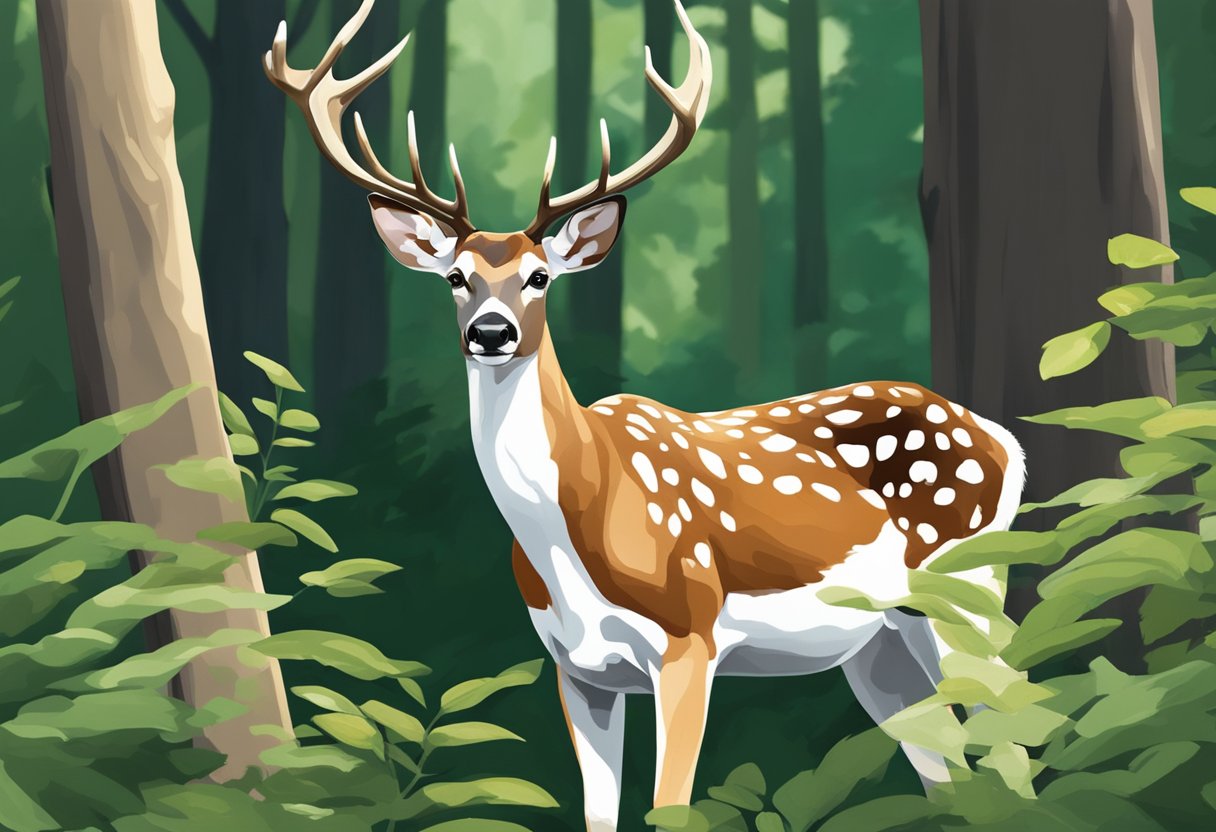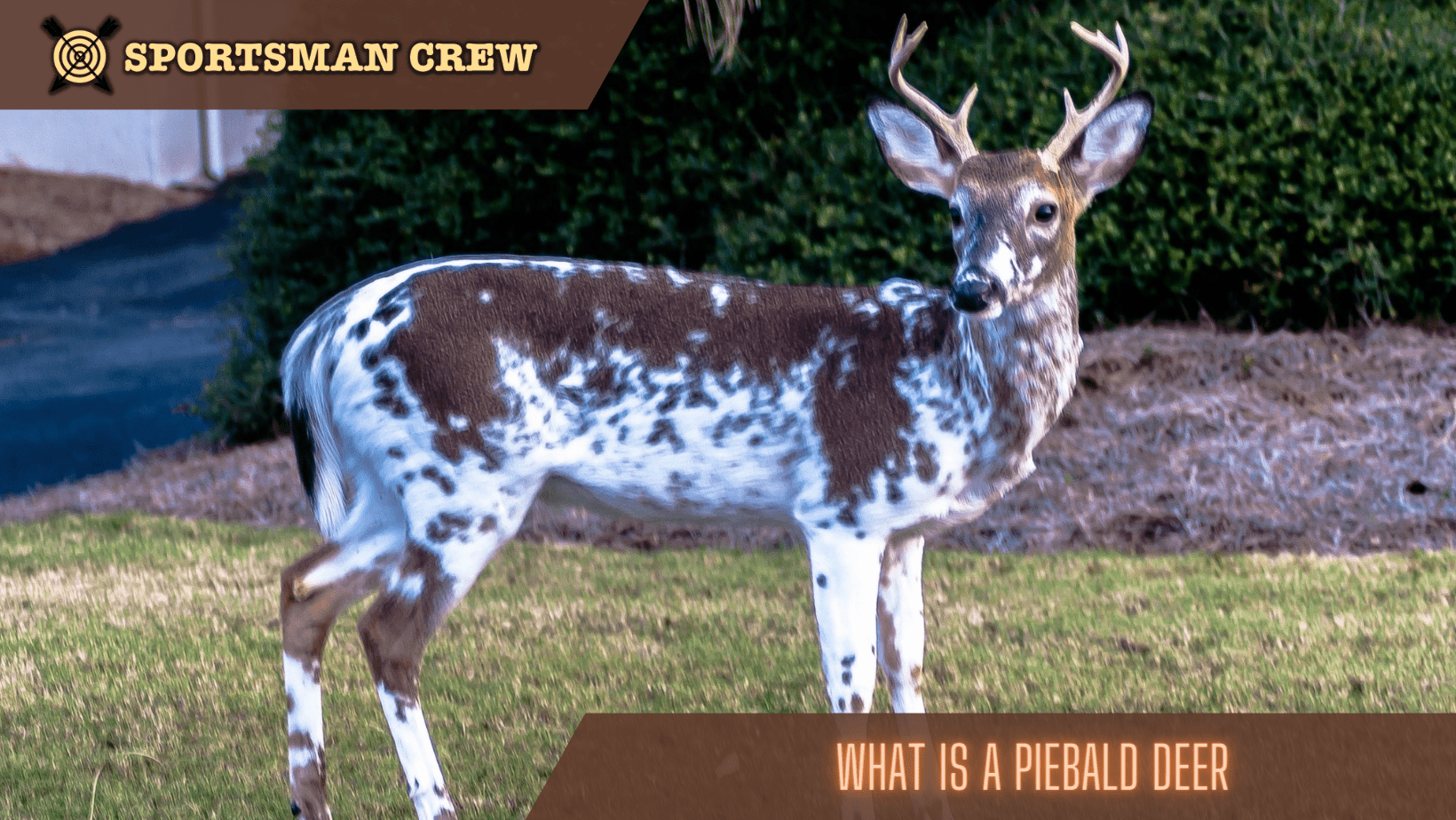A piebald deer is a striking creature distinguished by its unique coat, which features irregular patches of white and brown fur. This coat pattern is the result of a genetic mutation that affects pigmentation. Though similar in behavior and diet to other members of the deer family, piebald deer are rare, with their distinct appearance making them an object of both fascination and study.

The genetic mutation responsible for the piebald appearance is not merely cosmetic. It can sometimes be associated with other physical abnormalities, including skeletal misalignments and organ issues. Despite these potential health concerns, piebald deer are able to live in the wild, although their survival can be challenged by their more conspicuous coloring which can attract predators.
Key Takeaways
- Piebald deer exhibit a rare genetic mutation that leads to their distinct coloration.
- These deer may experience related physical anomalies beyond their unique pigmentation.
- The rarity and distinctive appearance of piebald deer have significant cultural and conservation implications.
Table of Contents
Understanding Piebaldism

Piebaldism is a condition characterized by irregular patches of white and colored fur, resulting from genetic variations. It’s crucial to differentiate piebaldism from other pigmentation conditions, as it involves specific genetic factors and presents distinct patterns.
Genetic Foundations of Piebaldism
Piebaldism arises from a recessive gene that leads to a lack of pigmentation in certain skin areas. This genetic mutation affects the distribution of melanin, the pigment that colors the skin, fur, and eyes of animals. Not all animals carry this gene; it is a rare genetic abnormality that results in the distinct patches of white and normal-colored fur seen in piebald animals.
The inheritance of piebaldism follows a recessive trait pattern. This means that an animal must receive the gene from both parents to express the condition. The variable expression of this piebald trait is why the extent of the white patterning can differ significantly even within the same species.
Piebaldism vs. Albinism and Melanism
While piebaldism involves a recessive gene leading to a partial lack of pigmentation, albinism is a condition characterized by the complete absence of melanin production due to a genetic mutation. An albino animal will have white or pale skin and fur with pink or red eyes, lacking pigmentation throughout their entire body.
On the other hand, melanism refers to an overproduction of pigment, resulting in animals with darker-than-usual coats. Melanistic deer, for instance, are much more uniformly black because of the high levels of melanin. Leucism, another condition distinct from piebaldism and albinism, results in reduced pigmentation across the entire body but is not due to a lack of melanin specifically.
Understanding these genetic conditions is crucial for recognizing the differences between piebald, albino, melanistic, and leucistic animals, as they have different genetic foundations and visual characteristics. Piebald animals exhibit a unique beauty marked by the contrasting patches that result from their genetic variation.
Identifying Piebald Deer
Piebald deer are distinguished by their unusual coat patterns and potential skeletal irregularities. Essential identifiers include variations in coat coloration and physical attributes correlating with piebaldism.
Physical Characteristics
Coat Coloration and Pattern: The most recognizable feature of a piebald deer is its coat, which exhibits patches of white and brown that contrast starkly against the typical uniform color of deer. This piebald pattern results from a genetic anomaly that causes the deer to display these irregular, mosaic-like white areas on their body.
- Eyes and Nose: Sometimes, their eyes may be blue, a trait that is atypical to the normal brown-eyed deer population. The nose may present a distinctive bowing, diverging from the standard deer conformation.
Skeletal and Physical Deformities:
- Spine and Legs: A piebald deer might have an arched or misaligned spine and legs that may appear shorter, crooked, or deformed. These irregularities can impact their movement and overall survival.
- Hooves and Jaws: Deformed hooves and shortened jaws are also commonly noted in these animals.
Behavior and Abilities
- Camouflage and Predation: Due to their conspicuous coat patterns, piebald deer are less adept at camouflage, potentially increasing their visibility to predators.
- Survival: Their atypical physical characteristics can sometimes impair their ability to escape threats quickly. They are more susceptible to predation because their chances of survival are often compromised by both conspicuous appearance and the possibility of skeletal impediments affecting movement in response to sudden movements or loud noises.
In summary, piebald deer can be identified by their distinct white and brown coat colors and a varying range of physical deformities. These characteristics can influence their behavior and survival in the wild.
Habitat and Distribution
Piebald deer, a genetic variant of the white-tailed deer, are distributed unevenly across their range, with specific habitat preferences influencing their presence.
Geographical Range
Piebald deer are found throughout North America, primarily within the range of the white-tailed deer population. While sightings are rare due to their low occurrence rate, reported cases have particularly sprouted up across various states in the United States, including Minnesota. No concerted conservation efforts are specifically tailored to piebald deer due to their genetic anomaly status, but their existence falls under the general management of wildlife and their habitats.
Habitat Preferences
These unique deer favor habitats similar to normal white-tailed deer. They thrive most efficiently in the forests and fields that offer a mix of cover and open spaces. Their presence is more notable in regions with significant white-tailed deer populations. While they do not have a specific conservation status, the health of the general deer population and their habitats indirectly impacts the presence of piebald deer.
Impact on Survival

The survival of piebald deer is intricately linked to their distinctive coloration and genetic makeup. This rare genetic trait not only affects their appearance but also has significant implications for their health and interactions with predators.
Health and Longevity
Piebald deer carry a genetic trait that results in their unique coat pattern, but it can also lead to health challenges. These deer may experience internal organ deformities, which can impair their overall health. A piebald fawn may face a host of health implications that can reduce its chances of reaching full maturity, affecting not only individual survival rate but also the deer population’s stability.
Predation and Protection
The conspicuous coloration of piebald deer makes them more visible to predators, compromising their natural protection mechanisms. Their survival is further threatened as these visuals inhibit their ability to blend into their surroundings, increasing predation risk. However, the survival capacity of each piebald deer can vary significantly depending on the environment and the presence of protection measures or refuge areas within their habitat.
Cultural and Symbolic Significance

Piebald deer have been steeped in cultural and symbolic importance across various societies, often associated with mythology, spirituality, and modern interpretations. These distinctive creatures have inspired a breadth of beliefs and meanings attributed to their unusual coloration.
Mythology and Superstitions
Piebald deer are surrounded by various myths and superstitions. In some cultures, their striking appearance has led to beliefs that they could possess mystical qualities or bring about significant change. It has been a common superstition that sighting a piebald deer could either signal bad luck or, conversely, be a good omen.
Native American Perspectives
Within Native American cultures, the piebald deer hold a different view. They are sometimes considered sacred and are often respected and admired. The unique coloration of piebald deer is seen as a bridge to the spirit world, aligning with wider Native American beliefs. These animals can carry powerful symbolism within tribal stories and convey cultural significance.
Modern Perceptions
In modern times, perceptions of the piebald deer have evolved beyond the realms of superstition and sacredness to broader ecological and genetic interest. While still carrying a sense of wonder, piebald deer are often used in discussions about biodiversity and the importance of genetic variations in wildlife populations.
Conservation and Legal Status

The conservation and legal status of piebald deer encompasses specific hunting regulations and deer population management strategies aimed at sustaining their numbers while considering their unique genetic traits.
Hunting Regulations
In various jurisdictions, hunting regulations have been established to define the legal status of piebald deer. For example, in Wisconsin, piebalds are legal to shoot, encompassing deer that display the distinct piebald coloration due to a genetic variation. It’s crucial for hunters to familiarize themselves with local hunting laws as they can vary significantly by state and region. Enforcement of these laws ensures that hunting is conducted ethically and responsibly.
Deer Population Management
Deer population management is a critical component of wildlife conservation, particularly in maintaining a balanced ecosystem. While white-tailed deer are common, piebald individuals are rare. Wildlife rehabilitators and conservationists may be involved in management to safeguard genetic diversity within deer populations. The strategies implemented may include monitoring populations, habitat management, and research. Such efforts aim to support the health of the overall whitetail population, which in turn has implications for local hunting culture and conservation efforts.
Hunting Considerations
When it comes to hunting piebald deer, hunters face unique ethical and regulatory challenges due to the deer’s rarity and the cultural significance they hold in some areas. Knowledge of hunting laws and the genetic implications of targeting piebald deer is crucial.
Ethical Hunting Practices
Hunters should approach piebald deer with a strong sense of stewardship. Taking into consideration the rarity of a genetic anomaly that produces the piebald condition is important. Ethical considerations include whether to target these animals, as their unique appearance can make them highly sought after as trophies. This popularity could potentially harm the stability of local deer populations if not managed correctly.
Hunting and Piebald Deer Rarity
Piebald deer are quite rare, occurring in less than 1% of the white-tailed deer population. Sites like the Seneca Army Depot in New York have become known for a higher concentration of white and piebald deer, leading to specific regulations and hunting laws to protect these uncommon animals. Hunters should familiarize themselves with local hunting laws to ensure they are in compliance when pursuing these distinctive deer. The significance of the piebald deer’s appearance—along with its uniqueness—contributes to the complexity of hunting culture and conservation efforts, making informed discussions on hunting regulations and practices essential.
Genetic Research and Future Implications

Recent genetic research has shed light on the causes of piebaldism in deer and its potential effects on deer populations. This research is pivotal for managing wildlife and understanding genetic diversity.
Genetic Causes of Piebaldism
Scientists have identified that piebaldism in deer is due to a recessive genetic trait. Specifically, this condition is caused by a mutation in a gene which results in the distinct white and brown patterning of the coat seen in these individuals. A deer must inherit the piebald gene from both parents to exhibit the trait, making it a relatively rare occurrence in wild populations. This discovery enhances understanding of deer genetics and can inform conservation strategies.
Impact on Deer Health and Popularity
Research has indicated that, alongside their unique appearance, piebald deer may suffer from a range of health issues, including skeletal misalignments and organ defects. Conservationists and wildlife managers are concerned about the welfare of these animals in the wild, considering these potential health problems.
Conservation and Management Strategies
The implications of genetic research on piebald deer influence conservation efforts. Wildlife management programs aim to maintain genetic diversity while considering the health and viability of deer populations. Strategies may involve monitoring the prevalence of the piebald trait within herds and managing breeding patterns to prevent potential negative impacts on the herd’s health and genetic diversity.
Future Directions in Research
Future research aims to delve deeper into the genetic mechanisms behind piebaldism and its inheritance patterns. This may include genomic studies that could lead to advancements in understanding wildlife genetics and the evolution of rare traits. The outcomes of such studies are anticipated to play a critical role in developing informed management policies to ensure the sustainability of deer populations.
Frequently Asked Questions

Piebald deer are intriguing creatures due to their unique coloration, and many people have questions about this rarity in nature. This section aims to address some of the most common inquiries.
How rare is the occurrence of piebaldism in deer populations?
Piebald deer are exceptionally uncommon, with less than 2% of the white-tailed deer population exhibiting this condition.
What are the distinguishing physical characteristics of a piebald deer?
A piebald deer typically has a white and black coat, which is the result of a genetic anomaly. These deer may also display patterns that may include white fur patches alongside a more consistent base color.
Are there any health implications associated with piebaldism in deer?
The piebald condition can sometimes be associated with other physical anomalies, such as deformed hooves or shortened jaws. However, not all piebald deer will have such issues.
Is the hunting of piebald deer regulated or restricted in certain regions?
Regulations on hunting piebald deer vary by region, with some areas implementing specific measures due to their rarity; however, details on hunting regulations should be checked with local wildlife authorities.
What genetic factors contribute to the piebald condition in deer?
Piebaldism in deer is caused by a recessive gene that affects melanin distribution – the pigment that colors skin, hair, and eyes – resulting in the distinctive piebald patterns.
Can piebaldism be attributed to inbreeding amongst deer?
There are cases where inbreeding can increase the likelihood of recessive traits like piebaldism occurring, but piebaldism on its own is not indicative of inbreeding.
